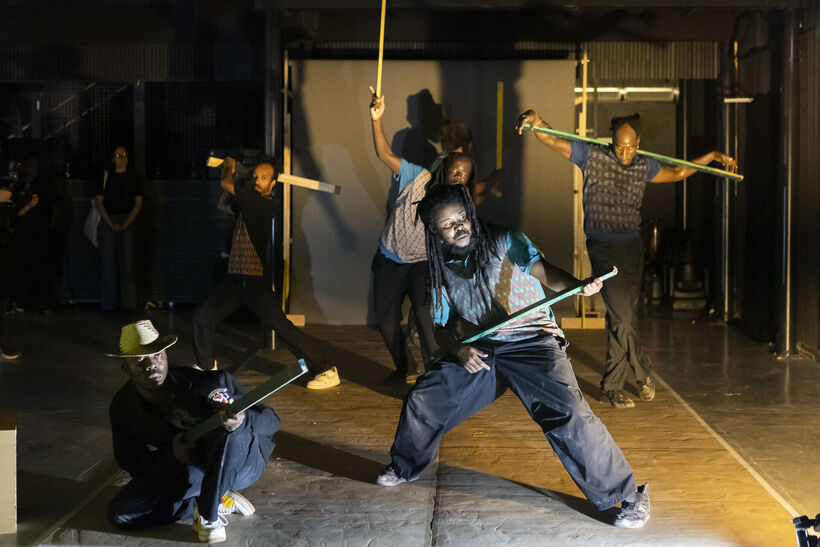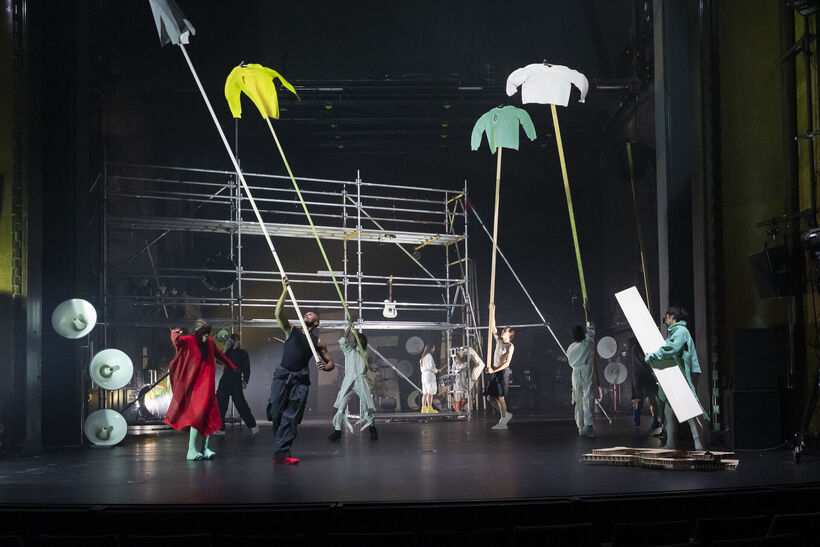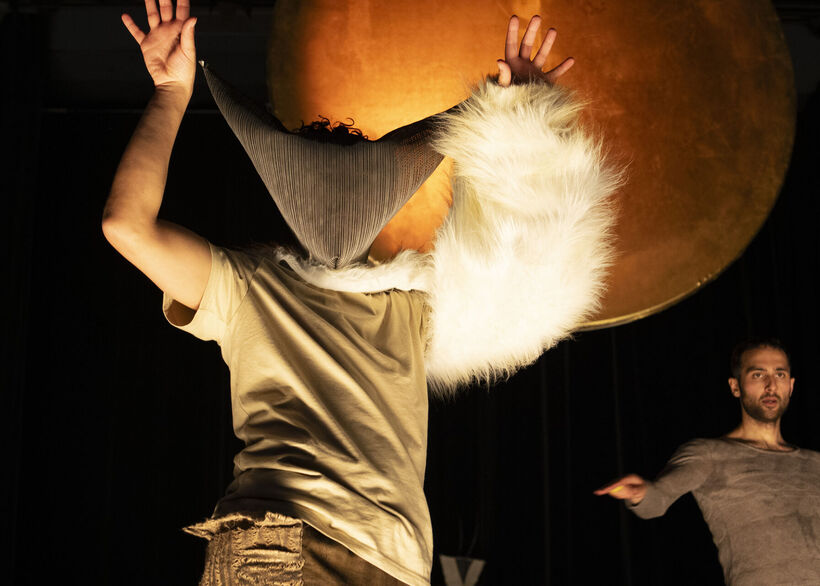As is traditional, performances are spread across the city, and audiences move with them through venues such as HAU Hebbel am Ufer, Haus der Berliner Festspiele, Alte Münze, Radialsystem, Sophiensæle, St. Elisabeth-Kirche, and Tempelhofer Feld. Tanz im August reasserts its role as a key observatory for contemporary dance, seen as both a critical and sensory language.
Tanz im August 2025 – Telluric Horizons
“The ground is moving, and we are moving with it”, writes artistic director Ricardo Carmona. Tanz im August 2025 stays true to this vision: dance as a seismograph of present-day tensions. Yet, in this telluric landscape, the promised collisions implied by fault line theme rarely occur. Plates shift, but seldom clash. The festival favours vibrations over earthquakes, controlled friction over eruption. It presents slow transformations rather than sudden shocks—a careful, gradual construction and a subtle resistance of gesture, perhaps conscious of an era marked by climate crises and ongoing conflicts.
In his curatorial manifesto, A Landscape of Fault Lines, Carmona maps a telluric horizon: fault lines as spaces of tension, collision, and emergence. Annemie Vanackere, HAU director, introduces another perspective: an “ecology of dance” threatened—and already impacted—by austerity measures and an unstable cultural landscape. Geological and ecological metaphors converge in dance’s expanded practice: an art form that registers the vibrations of the present, oscillating between resistance and transformation.
While some of the more striking works—Derniers Feux, Dambudzo, Trailer Park—capture the jolts of the moment, what prevails is a slow drift, a persistent vibration. Not an eruption, but constant pressure—a deep movement that rarely breaks the surface. Across the ten pieces I experienced, the festival sketches a complex cartography: a geology of gestures, sounds, and rituals measuring the tension between body and world, between the possibility of community and the threat of fragmentation. Yet what lingers most is the care and kindness with which audiences are welcomed by the festival’s collaborators. It might seem a small detail, but it shapes the Tanz im August experience profoundly. In a context where large-scale cultural events can often feel impersonal, this attentiveness and cordiality form a subtle choreography that mirrors the sensitivity and nuance on stage. Amid fault lines and gentle tremors, human connection emerges as one of the festival’s most vital threads.
Seismic Bodies
The festival’s first German premiere, Clara Furey’s UNARMOURED, opens with a quartet of queer artists laid bare—unarmoured, as the title suggests—exploring power, desire, and vulnerability. The performers inhabit a suspended, almost otherworldly space, bathed in milky green light that transforms the stage into a pulsating chamber. Bodies sway like waves, stretching toward collapse or recoiling in micro-movements, as if testing gravity itself. The effect is hypnotic: a collective breath shaping an intimate, unstable, profoundly human topography. Repetition becomes a dramaturgical device, each cycle of movement layering meaning.
Twin Rising’s electronic score, with its pulsing basslines, introduces a contrasting rhythm: bodies resist its linearity, creating tension between sound and gesture. In the climactic finale, a rave-like sequence erupts and dissolves into a bare image: a naked body, contorted in a white light, emblematic of a post-human creature existing only in the tension between flesh and technology. Vulnerability becomes political, reclaiming the complexity of the body in an age of algorithmic control.
UNARMOURED impresses with its aesthetic coherence and the plasticity of its performers. Even when repetition risks monotony, it underscores a critical insight: like desire, dance progresses not by accumulation but by return—constantly rewriting the boundaries of the self.
In Derniers Feux, Némo Flouret shifts the focus to the body’s materiality. Cardboard, sticks, fabric, and ropes become extensions of gesture, alive within the choreography. Objects fall, bounce, and crumple in continuous cycles of construction and collapse, as if an invisible force alternates between attraction and repulsion, order and decay. The title evokes not explosive fire, but the tense anticipation before ignition—a suspended, vibrating moment, rich with potential energy.
The performance’s rhythm emerges from live music, which interacts with bodies and objects rather than merely accompanying them, generating a constantly morphing soundscape. Scenes become ephemeral ecosystems, where nothing remains unchanged. There are echoes of Théâtre du Radeau in the transformation of stage into visual thought, mingling with a dreamlike, Fellini-esque quality of ruins, construction sites, and wandering figures. Flouret balances urgent gesture with compositional precision, avoiding both chaotic rhetoric and disaster aesthetics. The result is a piece that never truly explodes—leaving the audience suspended, caught in the breath before the flash.
Adam Linder’s TOURNAMENT, with composer Ethan Braun, offers a sensory exploration of dance, music, balance, and disorder. Five dancers engage with the Berlin-based Solistenensemble Kaleidoskop, a group that has long experimented at the intersection of sound and gesture. A large white stepped structure dominates the space—a stage, stand, and observatory—where most of the action unfolds, though attention constantly drifts to scattered details: flowers, an out-of-sync barking dog, fragments of objects and costumes.
Braun’s score moves from dissonance to lyricism, creating a polymorphic symphony of buildup and rupture. Linder translates this energy into a choreography that alternates between elegance and nervousness, precision and abandon. The staircase, symbolizing ascent and hierarchy, becomes a playground of competition—a “tournament” of bodies and sounds vying for the centre. Dancers and musicians form a laboratory of mutual listening, a field of forces where formal order is constantly subverted by intrusions, noises, and sudden deviations. Throughout the performance, dance seems to dissolve into noise. Movements fracture, gestures echo sounds, generating an audiovisual experience that disrupts perception. It is a minor emotional earthquake, a destabilizing linear vision and inviting reflection on the very nature of harmony.
Magma
With NÔT (Creole for “night”), Marlene Monteiro Freitas confirms her talent for creating universes where dance becomes ritual, disorder, and vision. Loosely inspired by One Thousand and One Nights, the Cape Verdean choreographer crafts a dreamlike ceremony in which storytelling is no longer mere narrative, but a survival mechanism. Like Scheherazade, the performers seem to remain on stage to buy time, to forestall an ending—or perhaps to reinvent it each night.
The Haus der Berliner Festspiele stage is dominated by stacked beds, bloodied sheets, musical instruments, and masks: an eerie space that might evoke a hospital or a fantastical asylum. Yannick Fouassier’s lighting amplifies the visionary quality, layering visual planes and optical illusions that mirror the performance’s internal tension. The performers build a language of repetition and spasms, gestures reiterated to exhaustion, producing a rhythm that goes from calm to fury. Freitas orchestrates excess, channelling scenographic violence through minute details: disproportionate postures, fixed gazes that confront the audience.
NÔT’s nights are never quiet. Set to the Stravinsky’s Les Noces choir and punctuated by percussive rhythms, the performance brims with spectral and clownish figures, musicians, and dancers, all emerging from a distorted dream—or a disquieting celebration. The closing to Nick Cave’s The Mercy Seat casts a melancholic tone, leaving the body exhausted. While visually powerful and formally precise, the work feels episodic, a mosaic of disjointed dreams. This discontinuity is both its strength—a rhythm over logic—and its weakness, leaving the emotional resonance somewhat uneven.

In Dambudzo (“anger” in Shona), Nora Chipaumire grounds ritual in territory, transforming dance into a political and communal act. In the sweltering Alte Münze, a space the festival has recently started using, the Zimbabwean choreographer—now sixty and based in New York—creates a hybrid performance combining installation, concert, and ceremony. Sound, sculpture, and movement merge into a pulsating environment where art is experienced collectively. Disco balls, booming speakers, strobe lights, and Afropop rhythms conjure the energy of an African dance party in Berlin, while underlying the celebration is a reflection on colonialism, freedom, and the reinvention of community through the body.
The audience is fully immersed, participating physically in the collective ritual by running, singing, making rebellious gestures, and performing liberating dances—no stage, no auditorium, just common ground where new worlds are imagined. Coloured, transparent, mobile panels create permeable boundaries between freedom and control, community and individuality. Standout moments include mud thrown onto walls as impromptu sculpture, umbrellas waved as ceremonial weapons, and voices chanting “Hallelujah,” echoing Africa’s forced Christianization. Chipaumire weaves philosophical thought, biography, and contemporary politics, turning the performance into an act of memory and radical imagination. Dance here is a shared experience: rhythm, sweat, joy. The festival atmosphere amplifies this: the audience sweat, laugh, dance, drink beer and water, and the performance obliterates distance.With the German premiere of Magec / The Desert, Radouan Mriziga transforms the stage into a spiritual landscape, where dance becomes both visual meditation and political act. Named after the divine sun of Amazigh mythology, Magec reflects Mriziga’s pursuit of indigenous North African cosmologies, interwoven with contemporary hip-hop, electronic music, and European performance art.
The scene glows in a warm, golden light, dominated by a large rotating disc that evokes the sun, moon, time, and movement. Performers wear colourful, architectural garments and large animal masks—foxes, antelopes—they burn incense and trace deliberate paths across the stage. The first part of the show is contemplative, with slow rhythms and geometric body formations that create ritual maps. Gradually, the liturgy transforms: a shaman-DJ begins mixing electronic, drum and bass, and hip-hop, performers remove their masks, movements quicken, bodies explode with energy. Dance shifts from meditative geometry to breakdance, from ritual circle to club, merging past and present, spirituality and pop culture. This tension reflects a society suspended between roots and modernity, memory and future. After the energetic climax, the group returns to the original circle: bodies regroup, male voices rise in slow song, gestures evoke animals and landscapes. The choreography closes its cycle, like a breath absorbed back into the earth.
Ecologies of Gesture
With Jungle 정글, Kim Sungyong guides fifteen dancers from the Korea National Contemporary Dance Company on a sensory journey through a reinvented nature. The jungle symbolism—deployed as a metaphor for life’s complexity—permeates the work. Kim treats it as a figure of inner nature, composed of layers, darkness, and invisible interconnections. The stage, shrouded in mist, is a space balanced between artifice and organicity: a cage-like ceiling, suspended leaves, and green and orange lights create a hypnotic ecosystem where shadows and bodies chase one another.
Built on controlled improvisation, the choreography unfolds through micro-movements, slides, and slow shifts that reveal the extraordinary precision and sensitivity of the performers. Bodies move plastically, seemingly listening to an inner nature rather than an external landscape. Sungyong constructs a language that blends discipline and trance, geometry and breath, highlighting dance as a process of perception rather than representation.
Marihiko Hara’s music—a tapestry of strings, metals, electronic sounds, and amplified breaths—is integral to the dramaturgy. More than accompaniment, it forms a sonic environment in which movement finds its echo. Every gesture produces an ambient wave; every step alters the acoustics of the space, creating a “perceptual ecology” where body and sound influence one another. Sungyong showcases the contemporary Korean stage’s blend of precision, spirituality, and technological sensitivity. In From Rock to Rock… aka How Magnolia Was Taken for Granite, Jeremy Nedd delivers one of the festival’s most subtle and conceptually sharp experiences. Working with four performers, the Swiss-American artist begins with a simple but radical question for contemporary dance: “Who owns a dance move?”
The piece deconstructs the Milly Rock, a gesture popularized in hip-hop by rapper 2 Milly, whose widespread reach—through TikTok tutorials, for example—has diluted its cultural and political roots. Nedd does not merely reference it: he dismantles it, slows it down, and multiplies it, revealing its hidden structure and transforming it into a meditation on memory and transmission.
The space is minimal: everything is white—the performers’ pastel-toned suits, the curved backdrop, a central stone “mountain.” In this neutral landscape, each gesture stands out like an incision. The choreography unfolds in precise blocks of repeated movement, while live music and singing add intimate, ritualistic dimensions. Nedd constructs a choreography of subtraction, reducing movement to its essence—body, space, breath—exploring its original power and tracing genealogies of style. The piece functions as an act of restitution: the Milly Rock, purified of its digital-consumption context, re-emerges as a poetic gesture and a fragment of collective choreographic knowledge.
With Specky Clark, Oona Doherty returns to narrative and spoken word without sacrificing her physical intensity. The piece, named after the artist’s great-grandfather, tells a universal story of survival and resilience, emerging from trauma and family memory. Blending oral storytelling, gesture, and Irish folklore fragments, the stage is populated with symbolic objects—a fantastical piglet costume, sheets, appearing and disappearing ghosts—that become prosthetics of memory. Doherty operates as an archaeologist of the everyday, excavating inherited gestures and habits, restoring the body as an affective and social archive.
Her choreographic language is essential: dance emerges intermittently, like a sudden echo of the narrative. Doherty’s physicality—always raw and recognizable—becomes the point of contact between individual and collective memory, connecting a working-class family’s history to a wider communal experience. She tells her story without sentimentality, with emotional precision that allows space for vulnerability. The work marks a radical return to narrative while retaining physical density.
Finally, in Trailer Park, Moritz Ostruschnjak presents one of the festival’s most powerful creations. The stage becomes a contemporary arena where dance meets digital culture, with ten dancers from TanzMainz moving through viral gestures, remixes, memes, and visual overload. Ostruschnjak constructs a hyper-structured choreography reflecting the body’s transformation in the digital age, balancing critique with fascination rather than falling into didactic irony.

The stage edges are littered with energy drink cans; dancers wear sportswear covered in logos and slogans, body-brands moving in an advertising universe where every gesture seems for sale. Through intelligent montage and sampling, Ostruschnjak transforms this visual excess into layered choreography, combining rhythm (featuring a teasing, interrupted echo of Gigi D’Agostino’s timeless hit In My Mind), spatial construction, and surprise into a coherent, astonishing flow.
TanzMainz dancers’ balletic precision merges with the ironic superficiality of contemporary language. Movements derived from social media—poses, scrolling, freezes—are extracted from their original context and presented as pure gestures alongside glitch-like, rewound, abstract forms, allowing dance to reflect on everyday life in a digital era. Despite visual density, Trailer Park maintains structural and musical clarity, alternating lightness with pathos, irony with melancholy, inviting the audience to observe our time with both critical distance and tender engagement with its confusion.
Written from the Tanz Im August Festival from 13 to 30 August 2025.









